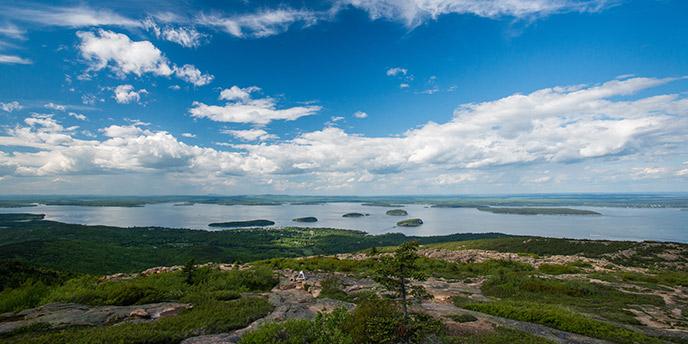The 2019 Light and Color in Nature scientific conference was held on the campus of the College of the Atlantic (COA) in Bar Harbor, Maine on the United States’ east coast. Dates for this meeting were 15-18 July 2019 (Monday-Thursday). Obviously, registration and submission of paper proposals for review are now closed.

College of the Atlantic campus in Bar Harbor, Maine
Arrivals and registration started on Sunday afternoon (14 July 2019), with departures from campus housing required by Saturday morning (20 July). Housing for 36 persons was available on campus in dormitory rooms; Bar Harbor has a wide range of hotel and motel lodgings, but you must have booked these as early as possible (no later than May). The College’s large lecture hall (Gates Center), which has a digital sound system & projectors, was ours to use from 0800-2100 EDT on Monday-Wednesday.
During the week of 15-18 July, we had coffee breaks at the lecture hall, plus an off-campus lobster dinner on Thursday evening. The latter was available at modest extra cost, and vegetarian options were available. Campus housing, dining, and the lecture hall are all within a short walk of one another. COA also let attendees purchase individual meals. For friends and families of attendees, we organized numerous optional weekday activities during sessions.
An optional “excursion day” was on Thursday (18 July), and no sessions were scheduled that day. Adjacent Acadia National Park offers a wide range of hiking & biking trails and nature programs, both within the park itself and on nearby inland and coastal waters. Thursday’s travels included a schooner sailing trip on Frenchman Bay, followed by a bus tour of the park, complete with spectacular mountain views.

Frenchman Bay seen from Cadillac Mountain in Acadia National Park, Maine
2019 paper proposals were considered on:
• Rainbows & fogbows
• Halos
• Glories
• Atmospheric coronas
• Iridescence
• Sky color & polarization
• Visibility through the atmosphere, including airlight
• Mirages & atmospheric refraction
• Crepuscular rays & other atmospheric/terrestrial shadows
• Contrast phenomena
• De-weathering (i.e., airlight removal)
• Cloud optics
• Optics of lightning
• Brightness & color of the sun & moon
• Auroras, airglow, & zodiacal light
• Green, blue, & red flashes
• Optics of dust, soil, & rocks
• Color & light on & in water
• Iridescence & colors in biology & geology
• Atmospheric optics in history & archaeology
• Physics-based simulations of atmospheric & environmental optics
• Sensors & imaging techniques for natural optical phenomena
• Lab experiments related to atmospheric & environmental optics
Standard talks were allotted 20 minutes each, followed by a 5-minute question period. Joseph Shaw and Montana State University (MSU) kindly agreed to act as institutional sponsor for the conference.
Raymond Lee
U. S. Naval Academy